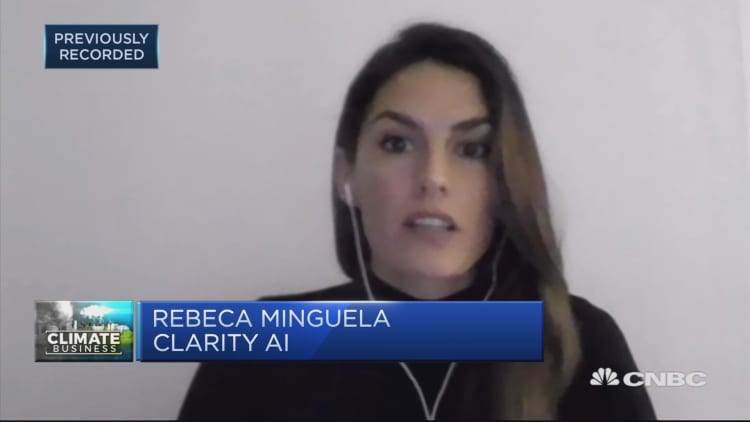As the Federal Reserve recently called out climate change as a stability risk, the investing world is recognizing the potential rewards of addressing the challenge.
"There's an overlap between climate change and long-term growth opportunities," said Eric Mancini, director of investment research and wealth advisor at Traphagen Financial Group in Oradell, New Jersey. "It's a 20- to 30-year growth opportunity as renewable energy gradually takes market share from traditional fossil fuels."
How does an investor tackle the huge topic of climate change to tap its opportunities? Natasha Lamb, managing partner, director of equity research and shareholder engagement for Arjuna Capital in Manchester-by-the-Sea, Massachusetts, offers a three-pronged approach:
- Determine what carbon assets you may be invested in, such as coal, oil and gas reserves. "There is a risk to your portfolio, as these companies will become unprofitable over time," she said. "For example, the cost to extract from oil sands is expensive."
- Think about how climate change can affects your entire portfolio "While negative stock screening can eliminate fossil fuel assets and mitigate some climate change risk, the rest of the stock in your portfolio could be impacted by economy-wide risk from storms, sea-level rise, population migration, supply chain disruption, challenges with insurance coverage, etc.," Lamb said.
- Look into investing in solutions that mitigate climate and portfolio risk, such as renewable energy solutions.
Screening positively or negatively
When evaluating individual stocks, one can screen them positively — for example, whether the companies be supported — or negatively, (e.g., whether they should be avoided.)
Sonia Kowal, president of Zevin Asset Management in Boston, said of the positive tack that "we're researching whatever companies are mobilizing fast enough to reduce their contributions toward climate change and anticipate and respond to market shifts that will be critical in a low carbon world."
It's also important to look at the physical risks resulting from climate change, she said. Particularly exposed sectors include logistics (e.g., air transportation, which is very vulnerable to extreme weather), banks and insurance companies that lend to or insure risk-exposed companies (e.g., large infrastructure projects), and agriculture and food (e.g., higher commodity costs resulting from droughts and pollinator disruption caused by rising temperatures).
Climate change will drive the demand.Marcio Silveirafinancial advisor with the Toler Group
"Companies from these sectors are in the S&P 500," Kowal said. "If you have a passive 401(k) that doesn't follow climate change indices, you're open to exposure over the long term."
Taking a deeper look at the agriculture sector, investors should also be aware of the climate risks caused specifically by industrial agriculture, said Rachel Robasciotti, founder and CEO of Adasina Social Capital in San Francisco.
"Farms themselves are giving off emissions," she said. "And genetically modified seeds, pesticides and synthetic fertilizers are stripping the soil of minerals."
In response, her firm is working on a public equities strategy, soon to be an index that will filter out companies involved in greenhouse gases, fossil fuels, pollution (e.g., spills, etc.), water management and the entities that fund them.

The right investment vehicles
For his part, Mancini suggests using sustainability-focused asset managers such as OpenInvest or Ethic to create a customized index. The advisor provides direction on where to invest client funds and the asset manager carries out the mandate; making the trades, rebalancing, undertaking tax loss harvesting, and providing measurable impact reports on how much carbon was saved and other ESG reporting, he explained.
There are also climate-related exchange-traded funds that focus on areas such as the utility companies transitioning to clean sources of electricity or start-ups creating new opportunities in solar, wind and hydro power, Mancini added.
Is that stock fund fossil-free?
Fossil Free Funds is a publicly accessible database of 3,000 stock funds available in the U.S., which tracks fossil fuel investments, carbon footprints and clean energy investments.
More and more of these specialized equity funds have launched in the last couple of years, said Marcio Silveira, financial advisor with the Toler Group in Silver Spring, Maryland. These include water funds, which invest in sewage systems and water purification, distribution and management systems; forest funds, which engage in "forest activism," by investing to create an impact through shareholder advocacy; and clean energy funds investing in specific technologies such as biomass, fuel cells and recycling.
Green bond funds are also a good option, he said.
"You're providing capital to the industries of the future," Silveira said. "They benefit more from the up side than the downside because of consumer demand.
"Laws and regulations may create incentives for these types of businesses, for example through tax breaks on green building and renewable energy," he added. "Climate change will drive the demand."
Another option is YieldCos, according to Michael Kramer, managing partner and director of research with Natural Investments in Kona, Hawaii.
"[These] are essentially renewable energy utilities, often tied to the grid," Kramer said. "They are lower risk than, say, companies that manufacture equipment.
"We like [them] for their long term power production and utility-scale investor dividends."


